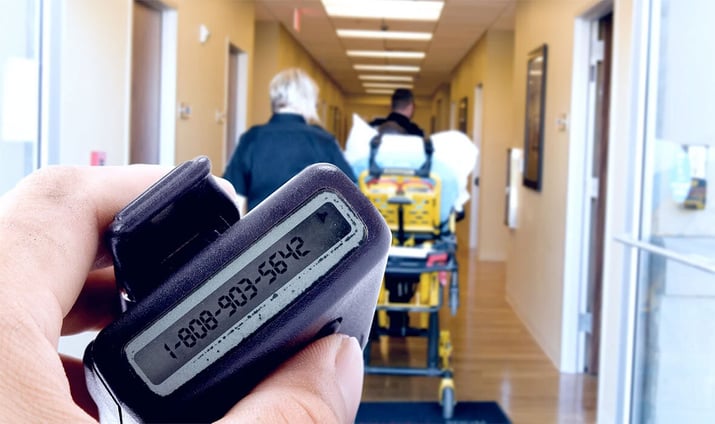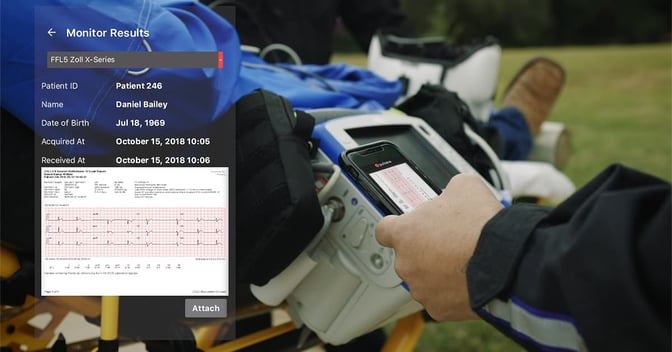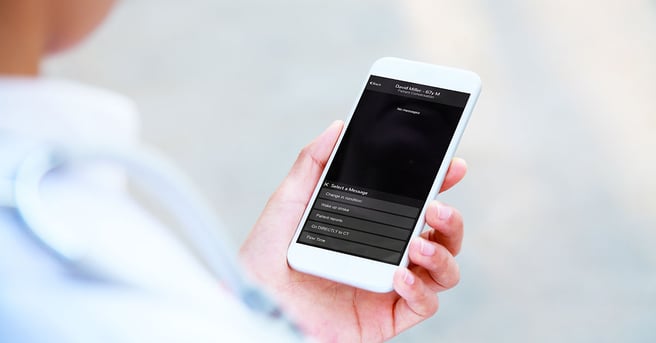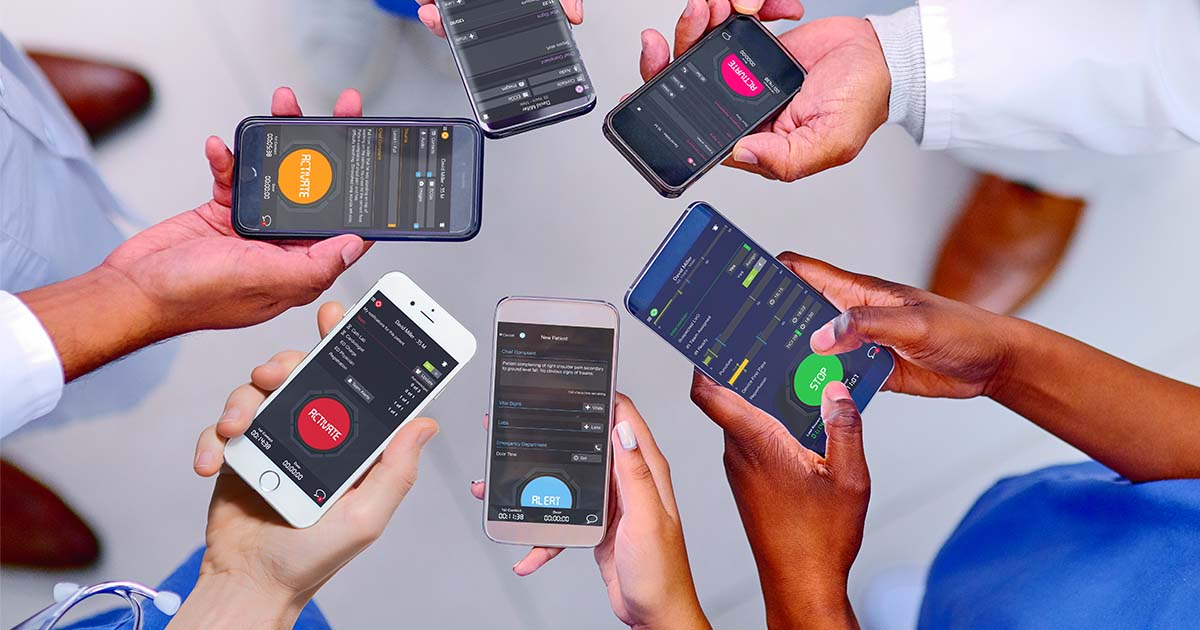Debunking the Myths of Integrated Mobile Technology
For a long time, pagers have been considered the logical choice for hospitals because they can get a message through even when a cell phone can’t get a signal. They have been standard in healthcare for over 40 years — for good reason.
However, mobile technology has come a long way over the past two decades. It's become the way we communicate for everything else in our lives. We text friends and family members. We can even order a pizza and track it to the front door. In the healthcare world, there have been holdups to converting to mobile technology, mostly due to concerns about the reliability of smartphones when compared to pagers. So, let's compare, contrast, and bust a few myths about pagers....
Which wastes more time: pagers, or cell phones?
Pager proponents argue that pagers get messages through more quickly and reliably than cell phones. And it’s true, pagers can send notifications quickly. However, the response process can be slow and time-consuming.
The wasted time accumulated from pagers is twofold:
- It often takes multiple people to send a page. In many systems, the MD or RN dictates the message to the unit clerk, who calls the operator to send a page. Sometimes, these pages even need to be set up in queue to be sent out. This is where the greatest delay is often located. With a configurable communication platform accessible across devices, it only takes one person to get the right message to the right person at the right time.
- Notifications are sent with limited information, often lacking context. This usually warrants a necessary yet time-consuming response in an attempt to understand the message. In addition, pagers don’t have read receipts, so you end up having to call to acknowledge the page or call to find out where communication was lost if the receiver is not responding to the patient.

Smartphones are able to transmit information much more quickly and with better context. With a HIPAA-compliant healthcare communication platform like Pulsara, you have the option to not only send clear, written-out messages, but you can also video chat in a way that is completely secure.
"Prior to this new technology, information was shared through multiple phone calls and pages. Now, with Pulsara, communication is precise, timely and consistent.”
— Carolyn Cook, RN MBA MNSc, Saint Mary's Regional Health System
What about connectivity and "dead zones"?
While dead zones do exist, they don’t only apply to smartphones. In order to send a page in the first place, you need connectivity. Once clinicians receive a page, they often need to go find connectivity to call and understand the context of the message...using their own cell phone! Not only does this waste time, but it can also create HIPAA compliance issues.
That’s not the only argument against cell phones, though. In addition to hospital dead zones, many rural EMS care teams have connectivity challenges, as there is little to no cellular reception outside of urban areas. Even with hotspots, there is no guarantee that the hospital will be able to receive all of the incoming data.
But before you throw smartphones out of the picture altogether, there’s another important question to consider: how is a page initiated?
Sending a page often requires a chain of events, using multiple mediums: verbal, landline, cellular, web (Wi-Fi or wired), etc. These resources can go down as well. You may be able to reliably receive pages, but what good is that if your method of sending them goes down?
Pulsara works to curb the issue of connectivity by working with Allerio and FirstNet to provide a dedicated public safety broadband communications platform, even in lower connectivity or rural areas. This allows care teams to focus their attention on what matters most: people.

Can I trust smartphones during disaster situations?
One major concern for users switching from pagers to smartphones is their scalability and durability during disaster situations. During many major disasters, local cellular networks become quickly overloaded or even disabled, proving virtually useless for emergency communications.
In any major disaster, you have two main choices: to be reactive or to be proactive. In order to be proactive, you must practice and be prepared for the real deal. Pulsara uses that concept and integrates it into public health and communications by creating a simple, scalable solution to fix a complex problem.
Montgomery County Hospital District EMS in Conroe, Texas, used Pulsara during the 2021 Valentine's Day winter storm, relying on the platform for continued communication among care team members and even between caregivers and patients.
Now that we’ve debunked some of the major myths in switching from pagers to smartphones, let’s jump into the major advantages of using your smartphone for communication within and across organizations.
Smartphones work across multiple networks.
Unlike pagers that only operate on a single network, smartphones can communicate across multiple networks, using both cellular and WiFi. In addition to working on multiple networks, FirstNet provides high-quality connectivity to care teams:
“The FirstNet mission is to deploy, operate, maintain, and improve the first high-speed, nationwide wireless broadband network dedicated to public safety. This reliable, highly secure, interoperable, and innovative public safety communications platform will bring 21st-century tools to public safety agencies and first responders, allowing them to get more information quickly and helping them to make faster and better decisions.”
When treating patients, we must connect the right clinicians with the right patient at the right time. Serving over 2.7 million square miles, FirstNet permits first responders to reliably access Pulsara's telehealth and communications platform, allowing them to ultimately improve the quality of care, patient outcomes, and efficiency of communication and coordination. In many cases, Allerio’s and FirstNet’s capabilities can facilitate connections so EMS teams can expect to treat less acute patients in the field, leveraging Pulsara’s live video for consultations, in even the most rural locations.
In the battle of smartphones vs. pagers, only one offers collaboration.
How much value are you getting from a one-way message?
A pager can’t be used to communicate lab results or request that a CT be performed with contrast. All you can do is request a callback, which wastes your time and requires finding connectivity.
Luckily, we no longer live in a world where one particular person wears all the hats. Care teams work together to treat patients. This includes physicians, nurses, social workers, techs, emergency services, and more. They are all collaborating and sharing information in a multi-directional manner in order to provide high-quality care to their patients. The smartphone and integrated applications are changing these discussions with the introduction of Pulsara’s secure communications and operations platform.

One nurse called Pulsara an "information superhighway" after experiencing the collaboration the communication platform offers:
"We've used Pulsara at our organization for about 4 years. Recently, we've expanded use to our sister hospitals. It has become like an information superhighway. The amount of time saved and the linear nature of the communication allows us to provide care in an efficient manner. I can not imagine going back to pagers, calls and nightmares to communicate during a potential endovascular case. Our Pulsara rep is FABULOUS, always there when we have questions or suggestions for improvement!"
— Rnrecholake, App Store, March 2021
A picture is worth 1000 words.
We live in a visual world, where much of our normal communication takes place through images. Pagers can’t take or transmit images or videos, but smartphones can! Pulsara offers completely secure, HIPAA-compliant camera support for pictures, video, and live video chat. But don’t just take our word for it. Here’s how Pulsara’s image feature was able to help clinicians at LewisGale Hospital Alleghany get a clearer picture of an incoming trauma patient:
"Covington EMS ran a trauma that was a significant tractor-trailer MVC. They could not fly the patient to the trauma center due to fog so they alerted LewisGale Hospital Alleghany that they were bringing the patient to us for stabilization and included an image of the accident scene [via Pulsara]. This picture was truly worth a thousand words as it was a much clearer visual of the scene than a verbal report could have relayed. The combination of the image and other data from EMS's early alert [via Pulsara] to the hospital allowed our ED staff to have all of the appropriate staff and equipment ready by the time the patient arrived. We were then able to focus our efforts on stabilizing the patient until air medical transport to the trauma center was available."
— Mary Wilhelm, ED Director of the HCA LewisGale Hospital in Alleghany
Our takeaway
While pagers have been a mainstay in healthcare for a long time—and for good reason—mobile technology can help improve the existing process and provide hospital staff with faster, more efficient communication, better transparency, and more information. For more efficient communication, switch to The Pulsara Way: a configurable system of care that scales to meet your needs in any dynamic event. By replacing multiple phone calls, radio reports, faxes, and pagers with one unified patient channel, care providers see reduced treatment times, reduced costs, and improve the lives of both patients and caregivers.

By replacing pagers and other forms of archaic technology with a mobile communication solution, ambulance and hospital care teams in Australia were able to provide faster treatment to stroke patients. Download the case study here.
 Isabella Rapp
Isabella Rapp




![[PRESS RELEASE] Published Research Finds Up to 31% Faster STEMI Treatment Times in Rural Hospital Setting with Pulsara](https://www.pulsara.com/hubfs/_1_website-page-blog-assets/pulsara-hosp-teams-assign-cardio-stemi-rn-1200x701.jpg)

